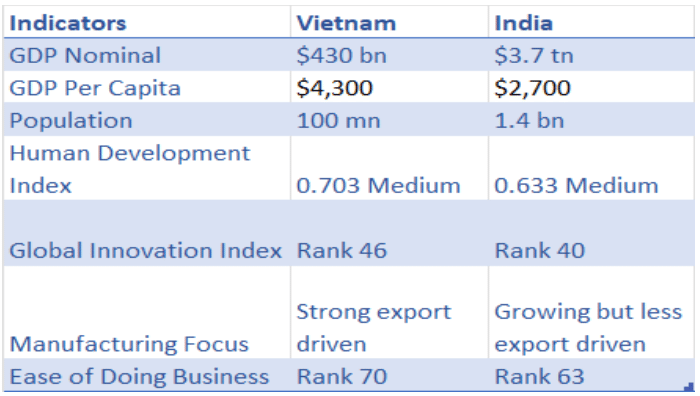Thank you dear subscribers, we are overwhelmed with your response.
Your Turn is a unique section from ThePrint featuring points of view from its subscribers. If you are a subscriber, have a point of view, please send it to us. If not, do subscribe here: https://theprint.in/subscribe/
Vietnam is one of the fastest-growing economies in Asia. Vietnam is an important manufacturing hub by becoming a key exporter of electronics, textiles and footwear. It’s integration with global trade organizations has augmented exports majorly to the markets such as the U.S and Europe. Significant improvements in transportation, education and technology infrastructure have fueled Vietnam’s growth, attracted foreign investments and improved living standards.
This article delves into Vietnam’s growth story, from a war-torn nation to a rising economic star.
Historical Background: Vietnam
The earliest known Dong Son civilization, existed around 1000 BCE, what is now called northern Vietnam. The Viet people established the First Vietnamese Kingdom under the Hong Bang Dynasty in 2879 BCE. The region became influenced by Chinese culture with diverse dynasties exercising control.
In the late 19th century, the French exploited resources and economic potential of Vietnam. This period sowed the seeds of nationalist movements and resistance against foreign invasions. After WWII, Ho Chi Minh led the Viet Minh (League for Independence of Vietnam) and culminated the Battle of Dien Bien Phu (1954), where the French were decisively defeated, leading to temporary division of Noth Vietnam (communist) and South Vietnam (capitalist).
After the division, Vietnam was caught in a Cold War, where the U.S supported South Vietnam and the Soviet Union backed North Vietnam. The Vietnam War (1955-75) was devastating and led to massive environmental and infrastructural damage. In 1975, North Vietnam successfully unified the country, and the Socialist Republic of Vietnam was established.
Economic Challenges: Vietnam
After reunification, Vietnam suffered severe economic challenges (1975-86), such as poverty, inefficiency in state-run industries and heavy toll of war. Even the centrally planned economy that was formed by the government struggled to provide food and growth and led to inflation. In 1986, the government began shifting to a socialist market economy from a command economy. Doi Moi reforms led to Vietnam’s economic transformation that encouraged – private entrepreneurship, foreign direct investment, and export-led growth in industries like textiles and electronics. The GDP growth rates started averaging 6-7 percent annually since then.
Vietnam became a global hub for manufacturing. Its competitive labor costs made it a lucrative destination for global companies. Ever since the Doi Moi reforms kicked off, Vietnam’s economy has grown rapidly, with per capita GDP rising from $220 in 1986 to over $4,000 in 2024.
Economic Development Snapshot: Vietnam and India

Geography and Demography: Vietnam
Vietnam is located in Southeast Asia, sharing northern borders with China, western parts with Laos and Cambodia, and the eastern region lies in South China Sea. Vietnam is a long S-shaped stretching 1,650 km from north to south, with a total area of 331,000 sq km. The northern terrain is mountainous with Red River Delta, central terrain has a narrow coast with highlands, and southern terrain is flat and fertile with Mekong Delta. Vietnam has a tropical climate and seasonal monsoons affect the area. Coal, oil, natural gas, timber and marine life are the natural resources of the country.
Vietnam has a population of 100 million, with a young and dynamic workforce with medium age of 32 years. Vietnamese is the official language. Vietnam has a mix of Buddhism, Christianity, and folk religions.
Vietnam as a Global Manufacturing Hub: Factors
Vietnam’s strategic location, favorable trade agreements, political stability, competitive labor costs and a viable alternative to diversify supply chains have positioned it as an attractive destination for manufacturing.
The U.S is increasingly sourcing from Vietnam to diversify supply chains and mitigate risks related to U.S-China trade tensions. Vietnam’s trade surplus with the U.S has reached $123.5 billion in 2024. China is investing in Vietnam with a focus on assembly and low to mid-end manufacturing ensuring products qualify as “Made in Vietnam”. South Korea has significant portion of smartphones in Vietnam, contribution notable to the country’s exports. Indian companies are investing in Vietnam’s renewable energy, digital infrastructure, and manufacturing sectors.
Conclusion
Vietnam’s growth story is remarkable, from overcoming war and colonialism to becoming a global manufacturing hub and a fast-growing economy in Asia. Despite all the economic challenges, its ability to evolve, adapt, reform and grow has paved the way for its success.
These pieces are being published as they have been received – they have not been edited/fact-checked by ThePrint.


